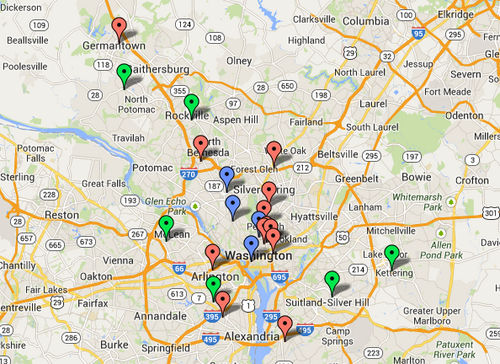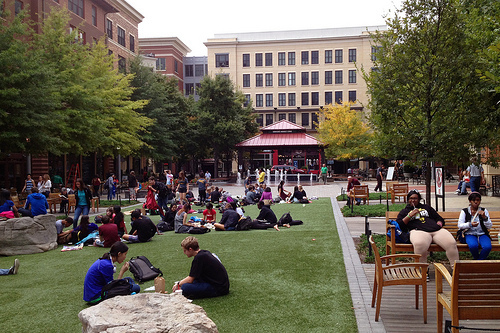What if we ranked schools based on their walkability?
Parents often choose schools for their kids based on test scores. But as more families seek out an urban lifestyle, what if we ranked schools on a kid’s ability to walk there as well?

Locations of the region’s most walkable high schools. Blue are schools in a “Walker’s Paradise,” red are “Very Walkable” schools, and green are “Somewhat Walkable.” Click for an interactive map.
Studies show that kids who live in walkable neighborhoods get more exercise and are at reduced risk for obesity. Being able to walk to school teaches kids independence and a stronger sense of community as well.
So where are students most likely to be able to walk to and from school? One indicator is a school’s Walk Score, a measure of its walkability. To find the region’s most walkable schools, I looked at the Walk Score of 95 public high schools (both neighborhood and magnet) in the District, Montgomery and Prince George’s counties in Maryland, and the city of Alexandria and Arlington and Fairfax counties in Virginia. Here’s a spreadsheet of all of the schools.
There were 22 schools in the “top 20,” which I’ve mapped above. (Three schools tied for 20th place.) Not surprisingly, nine of them are in the District. But there are also six in Montgomery County, two each in Prince George’s and Arlington, and one each in Alexandria and Fairfax. Seven of them are outside the Beltway.
Four schools were in the “Walker’s Paradise” category, Walk Score’s highest ranking. School Without Walls in downtown DC, came in first with a Walkscore of 97, followed by Columbia Heights Education Campus (94), and Woodrow Wilson High School in Tenleytown (92). Bethesda-Chevy Chase High School in Montgomery County made fourth place, with a score of 91.
Of course, Walk Score isn’t a perfect measure of walkability. It only measures an address’s proximity to commercial and institutional destinations, not the homes where students might be walking from. And it doesn’t consider the actual pedestrian experience. Seneca Valley High in Germantown, where a student died crossing the highway outside the school last year, placed 13th on the list with a score of 72.

Rockville Town Square is the de facto cafeteria of Richard Montgomery High School (Walk Score 65), located a few blocks away. All images by the author.
Some of these schools also have high academic ratings, like Richard Montgomery and B-CC in Montgomery, McLean in Fairfax, and Banneker in DC, all of which top the regional rankings in the Washington Post’s Challenge Index. But there aren’t a lot of them, and they’re in expensive neighborhoods. Many of the schools on this list are low performers; forced to choose, parents will usually always pick high test scores over a kid’s ability to walk to school.
My parents were no different. As a student at Wilson in the 1970s, my mother walked to lunch at Steak ‘N Egg Kitchen or to catch the 30 bus to her job at a clothing store in Georgetown. But I went to James Hubert Blake High School near Olney (Walk Score 11, or “car-dependent”), where nearly everyone drove, and gruesome car accidents were a fact of life. I once begged my principal for open lunch, but it wouldn’t ever happen: the nearest place to eat was over a mile away on a 40mph road with no sidewalks.
What else do you see in these rankings? And did you walk to school?
